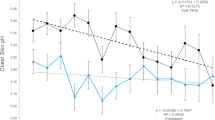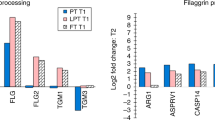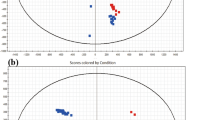Abstract
Objective:
The objective of this study was to determine the skin barrier changes during postnatal month 1 among infants receiving routine mustard oil massage in the humid conditions of rural Nepal.
Study Design:
This was an observational study among 500 live-born neonates receiving mustard oil massage. Skin integrity such as erythema, rash, dryness, skin pH, stratum corneum protein concentration and transepidermal water loss was measured on days 1, 3, 7, 14 and 28.
Results:
Erythema and rash increased (worsened) during weeks 1 and 2, then decreased over weeks 3 and 4. Skin pH (6.1±0.5 to 5.0±0.6) and stratum corneum protein (16.6±7.9 to 13.5±5.9 μg cm−2) decreased. Transepidermal water loss increased from 33.2±23.5 to 43.0±24.5 g m−2 h−1 at day 28. Skin pH and stratum corneum protein were higher for early versus late premature infants.
Conclusion:
Premature and full-term skin condition was generally poor especially during the first 2 weeks, improving thereafter. Maturational changes were evident.
This is a preview of subscription content, access via your institution
Access options
Subscribe to this journal
Receive 12 print issues and online access
$259.00 per year
only $21.58 per issue
Buy this article
- Purchase on Springer Link
- Instant access to full article PDF
Prices may be subject to local taxes which are calculated during checkout


Similar content being viewed by others
References
UNICEF, WHO, Bank TW, Division UNP Levels and Trends in Child Mortality. Report 2015 UNICEF: New York, USA, 2015.
GBD 2013 Mortality and Causes of Death Collaborators. Global, regional, and national age-sex specific all-cause and cause-specific mortality for 240 causes of death, 1990-2013: a systematic analysis for the Global Burden of Disease Study 2013. Lancet 2015; 385 (9963): 117–171.
Lawn JE, Cousens S, Zupan J . 4 million neonatal deaths: when? Where? Why? Lancet 2005; 365 (9462): 891–900.
Belizan JM, McClure EM, Goudar SS, Pasha O, Esamai F, Patel A et al. Neonatal death in low- to middle-income countries: a global network study. Am J Perinatol 2012; 29 (8): 649–656.
Mullany LC, Khatry SK, Sherchand JB, LeClerq SC, Darmstadt GL, Katz J et al. A randomized controlled trial of the impact of chlorhexidine skin cleansing on bacterial colonization of hospital-born infants in Nepal. Pediatr Infect Dis J 2008; 27 (6): 505–511.
Tielsch JM, Darmstadt GL, Mullany LC, Khatry SK, Katz J, LeClerq SC et al. Impact of newborn skin-cleansing with chlorhexidine on neonatal mortality in southern Nepal: a community-based, cluster-randomized trial. Pediatrics 2007; 119 (2): e330–e340.
Conde-Agudelo A, Diaz-Rossello JL . Kangaroo mother care to reduce morbidity and mortality in low birthweight infants. Cochrane Database Syst Rev 2016; (Issue 8): Ar t. No.: CD002771. DOI: 10.1002/14651858.CD002771.pub4..
Darmstadt GL, Badrawi N, Law PA, Ahmed S, Bashir M, Iskander I et al. Topically applied sunflower seed oil prevents invasive bacterial infections in preterm infants in Egypt: a randomized, controlled clinical trial. Pediatr Infect Dis J 2004; 23 (8): 719–725.
Darmstadt GL, Saha SK, Ahmed AS, Ahmed S, Chowdhury MA, Law PA et al. Effect of skin barrier therapy on neonatal mortality rates in preterm infants in Bangladesh: a randomized, controlled, clinical trial. Pediatrics 2008; 121 (3): 522–529.
Darmstadt GL, Saha SK, Ahmed AS, Chowdhury MA, Law PA, Ahmed S et al. Effect of topical treatment with skin barrier-enhancing emollients on nosocomial infections in preterm infants in Bangladesh: a randomised controlled trial. Lancet 2005; 365 (9464): 1039–1045.
Kelleher MM, O'Carroll M, Gallagher A, Murray DM, Dunn Galvin A, Irvine AD et al. Newborn transepidermal water loss values: a reference dataset. Pediatr Dermatol 2013; 30 (6): 712–716.
Visscher MO, Chatterjee R, Munson KA, Pickens WL, Hoath SB . Changes in diapered and nondiapered infant skin over the first month of life. Pediatr Dermatol 2000; 17 (1): 45–51.
Nikolovski J, Stamatas GN, Kollias N, Wiegand BC . Barrier function and water-holding and transport properties of infant stratum corneum are different from adult and continue to develop through the first year of life. J Invest Dermatol 2008; 128 (7): 1728–1736.
Hoeger PH, Enzmann CC . Skin physiology of the neonate and young infant: a prospective study of functional skin parameters during early infancy. Pediatr Dermatol 2002; 19 (3): 256–262.
Hachem JP, Roelandt T, Schurer N, Pu X, Fluhr J, Giddelo C et al. Acute acidification of stratum corneum membrane domains using polyhydroxyl acids improves lipid processing and inhibits degradation of corneodesmosomes. J Invest Dermatol 2010; 130 (2): 500–510.
Fluhr JW, Kao J, Jain M, Ahn SK, Feingold KR, Elias PM . Generation of free fatty acids from phospholipids regulates stratum corneum acidification and integrity. J Invest Dermatol 2001; 117 (1): 44–51.
Evans NJ, Rutter N . Development of the epidermis in the newborn. Biol Neonate 1986; 49 (2): 74–80.
Rutter N . Clinical consequences of an immature barrier. Semin Neonatol 2000; 5 (4): 281–287.
Sedin G, Hammarlund K, Stromberg B . Transepidermal water loss in full-term and pre-term infants. Acta Paediatr Scand Suppl 1983; 305: 27–31.
Agren J, Sjors G, Sedin G . Transepidermal water loss in infants born at 24 and 25 weeks of gestation. Acta Paediatr 1998; 87 (11): 1185–1190.
Kalia YN, Nonato LB, Lund CH, Guy RH . Development of skin barrier function in premature infants. J Invest Dermatol 1998; 111 (2): 320–326.
Mullany LC, Darmstadt GL, Khatry SK, Tielsch JM . Traditional massage of newborns in Nepal: implications for trials of improved practice. J Trop Pediatr 2005; 51 (2): 82–86.
Visscher M . A practical method for rapid measurement of skin condition. Newborn Infant Nurs Rev 2014; 14: 147–152.
De Paepe K, Houben E, Adam R, Wiesemann F, Rogiers V . Validation of the VapoMeter, a closed unventilated chamber system to assess transepidermal water loss vs. the open chamber Tewameter. Skin Res Technol 2005; 11 (1): 61–69.
du Plessis J, Stefaniak A, Eloff F, John S, Agner T, Chou TC et al. International guidelines for the in vivo assessment of skin properties in non-clinical settings: Part 2. transepidermal water loss and skin hydration. Skin Res Technol 2013; 19 (3): 265–278.
Parra JL, Paye M . EEMCO guidance for the in vivo assessment of skin surface pH. Skin Pharmacol Appl Skin Physiol 2003; 16 (3): 188–202.
Voegeli R, Rawlings AV, Doppler S, Heiland J, Schreier T . Profiling of serine protease activities in human stratum corneum and detection of a stratum corneum tryptase-like enzyme. Int J Cosmet Sci 2007; 29 (3): 191–200.
Darmstadt GL, Mao-Qiang M, Chi E, Saha SK, Ziboh VA, Black RE et al. Impact of topical oils on the skin barrier: possible implications for neonatal health in developing countries. Acta Paediatr 2002; 91 (5): 546–554.
Schmid-Wendtner MH, Korting HC . The pH of the skin surface and its impact on the barrier function. Skin Pharmacol Physiol 2006; 19: 296–302.
Fluhr JW, Pfisterer S, Gloor M . Direct comparison of skin physiology in children and adults with bioengineering methods. Pediatr Dermatol 2000; 17 (6): 436–439.
Fox C, Nelson D, Wareham J . The timing of skin acidification in very low birth weight infants. J Perinatol 1998; 18 (4): 272–275.
Hachem JP, Crumrine D, Fluhr J, Brown BE, Feingold KR, Elias PM . pH directly regulates epidermal permeability barrier homeostasis, and stratum corneum integrity/cohesion. J Invest Dermatol 2003; 121 (2): 345–353.
Voegeli R, Heiland J, Doppler S, Rawlings AV, Schreier T . Efficient and simple quantification of stratum corneum proteins on tape strippings by infrared densitometry. Skin Res Technol 2007; 13 (3): 242–251.
Haveri FT, Inamadar AC . A cross-sectional prospective study of cutaneous lesions in newborn. ISRN Dermatol 2014; 2014: 360590.
Zuniga R, Nguyen T . Skin conditions: common skin rashes in infants. FP Essent 2013; 407: 31–41.
Nanda S, Reddy BS, Ramji S, Pandhi D . Analytical study of pustular eruptions in neonates. Pediatr Dermatol 2002; 19 (3): 210–215.
Holzle E, Kligman AM . The pathogenesis of miliaria rubra. Role of the resident microflora. Br J Dermatol 1978; 99 (2): 117–137.
Foster KG, Hey EN, Katz G . The response of the sweat glands of the newborn baby to thermal stimuli and to intradermal acetylcholine. J Physiol 1969; 203 (1): 13–29.
Darmstadt GL, Ahmed S, Ahmed AS, Saha SK . Mechanism for prevention of infection in preterm neonates by topical emollients: a randomized, controlled clinical trial. Pediatr Infect Dis J 2014; 33 (11): 1124–1127.
Visscher MO, Utturkar R, Pickens WL, LaRuffa AA, Robinson M, Wickett RR et al. Neonatal skin maturation—vernix caseosa and free amino acids. Pediatr Dermatol 2011; 28 (2): 122–132.
Vyumvuhore R, Tfayli A, Duplan H, Delalleau A, Manfait M, Baillet-Guffroy A . Effects of atmospheric relative humidity on Stratum Corneum structure at the molecular level: ex vivo Raman spectroscopy analysis. Analyst 2013; 138 (14): 4103–4111.
Scott IR, Harding CR . Filaggrin breakdown to water binding compounds during development of the rat stratum corneum is controlled by the water activity of the environment. Dev Biol 1986; 115 (1): 84–92.
Trauer S, Richter H, Kuntsche J, Buttemeyer R, Liebsch M, Linscheid M et al. Influence of massage and occlusion on the ex vivo skin penetration of rigid liposomes and invasomes. Eur J Pharm Biopharm 2014; 86 (2): 301–306.
Kanti V, Bonzel A, Stroux A, Proquitte H, Buhrer C, Blume-Peytavi U et al. Postnatal maturation of skin barrier function in premature infants. Skin Pharmacol Physiol 2014; 27 (5): 234–241.
Denda M, Sato J, Masuda Y, Tsuchiya T, Koyama J, Kuramoto M et al. Exposure to a dry environment enhances epidermal permeability barrier function. J Invest Dermatol 1998; 111 (5): 858–863.
Agren J, Sjors G, Sedin G . Ambient humidity influences the rate of skin barrier maturation in extremely preterm infants. J Pediatr 2006; 148 (5): 613–617.
Fluhr JW, Darlenski R, Taieb A, Hachem JP, Baudouin C, Msika P et al. Functional skin adaptation in infancy - almost complete but not fully competent. Exp Dermatol 2010; 19 (6): 483–492.
Rosenberg RE, Ahmed AS, Ahmed S, Saha SK, Chowdhury MA, Black RE et al. Determining gestational age in a low-resource setting: validity of last menstrual period. J Health Popul Nutr 2009; 27 (3): 332–338.
Jehan I, Zaidi S, Rizvi S, Mobeen N, McClure EM, Munoz B et al. Dating gestational age by last menstrual period, symphysis-fundal height, and ultrasound in urban Pakistan. Int J Gynaecol Obstet 2010; 110 (3): 231–234.
Acknowledgements
This study was supported by the National Institute for Child Health and Development (HD060712) and the Bill & Melinda Gates Foundation (OPP1084399).
Author information
Authors and Affiliations
Corresponding author
Ethics declarations
Competing interests
The authors declare no conflict of interest.
Rights and permissions
About this article
Cite this article
Summers, A., Visscher, M., Khatry, S. et al. Indicators of skin barrier integrity among newborns massaged with mustard oil in rural Nepal. J Perinatol 38, 64–70 (2018). https://doi.org/10.1038/jp.2017.158
Received:
Revised:
Accepted:
Published:
Issue Date:
DOI: https://doi.org/10.1038/jp.2017.158



